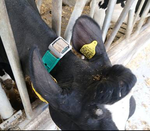


Using on-farm sensors in dairy farming is known to help decision makings and farmer objectives in the monitoring and potential improvement of animal behaviour, health and production performance. However, in indoor positioning systems, data interpretation is complicated by the inaccuracy and noise in the time series, missing data caused not only by sensor failure or the harsh and changing farm environments in which they operate, but also by the animals' specific physiology itself. Thus, working with spatial data has proven challenging mainly due to their enormous heteroscedasticity, which depends on multiple factors such as the cow, the time of the day, the behaviour, factors interfering with the sensor system, etc., for which we cannot account mathematically. Applying purely black-box approaches generally results in insufficient robustness, interpretability and generalisability.
With this work, Adriaens et al. (2022) developed a relatively simple and new methodology to monitor the lying behaviour of dairy cows by using noisy spatial positioning data, while combining time-series segmentation based on statistical changepoints and a machine learning classification algorithm. The two-step methodology identifies lying behaviour using an ultra-wide band indoor positioning system. Getting-up or lying-down events were indicated by the accelerometers. Overall classification and lying behaviour prediction performance was above 91% in independent test sets, with a very high consistency across cow-days. The robustness of the algorithm was demonstrated by the fact that both the cow identity-based split and the time-based split performed equally well.
The article represents an original contribution for advancing the state of the art in the automated quantification of lying behaviour in dairy cows, aiming to monitor health or animal welfare issues. Future research must be considered however to validate the performance of the model when using different position-measuring technologies, in other farm settings and over a longer period of time.
Reference
Adriaens I, Ouweltjes W, Pastell M, Ellen E, Kamphuis C. 2022. Detecting dairy cows' lying behaviour using noisy 3D ultra-wide band positioning data. Zenodo, 6627251, ver. 3 peer-reviewed and recommended by Peer Community in Animal Science. https://doi.org/10.5281/zenodo.6627251
DOI or URL of the preprint: https://zenodo.org/record/6373622#.YjmDQDXjKF5
Dear authors,
We have now received the required feedbacks from two reviewers and, before recommending your work as preprint, I recommend you to address the aspects that they have highlighted, with a view to further improving the quality of your manuscript.
Thanks again for your contribution to the PCI Animal Science project.
Best regards,
This is a very interesting work in which the authors explore the use of position data to predict the liying behavior.To do this, the authors suggest the analysis of data recorded by ultra-wide band positioning tags on the upside of a neck collar. This methodology may represent an advantage over other methods established for this purpose (accelerometers) or even emerging ones (computer vision).
Below are some comments that can make the paper easier to read, especially for those readers unfamiliar with this type of sensors and data analysis.
L20. To avoid misinterpretation, you can add the words "barn" in: "distance from the center"
L27-31. Although the performance of the prediction is presented, it is also interesting to briefly present, for example, the average difference between the liying time registered by the accelerometers and by the new methodology; or the average number of undetected lying bouts per day per cow
L72-73. Could you add some references that support the statement made in these lines?, like in L75
L91-93. Could you add a reference where the reader can find information about video-based systems?
L116-120. The methodological aspects described in these lines are addressed later, so these lines can be ignored.
L131-135. A technical aspect is pointed out, but the implications are not clear. If it's just a manufacturing feature, it can be ignored.
L165-166. Given the importance of the pre-specified origin (x,y,z)=(0,0,0), could you provide more information on the aspects that were considered when selecting it? Was there a single point of origin for both barns? Could the results be improved by using more reference points, mainly for (z)-position ?
L166-169. The values of the x and y axes in Figure 1 do not correspond to the description of these lines.
L171-172 Figure 1 do not correspond to the description of these lines. "When the y was larger than 11.5m, the animals were in the slatted flooring (feeding) area."
L182. It is not clear what it means:"These measurements were replaced by missing values."
L267-269. Did you perform preliminary tests to ensure this? Is there a minimum number of training segments that ensures optimal performance of the methodology?
L271. This was already mentioned: (alike the more classical machine learning approach)
L286-292. Could you add some references that support the statements made in these lines?
Below Table 2, information about the variables and values presented is required.
L342-344. But there is essentially no evidence to expect this.
In Figure 2 and 4. Replace the word "Class" ----> "ground truth" or "Truth". Also, information about the values presented is required.